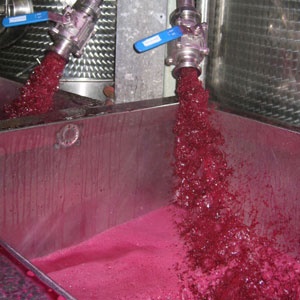Making wine is easy. Yes, really it is. It involves a very simple chemical equation which says
C6H12O6 => 2C2H5OH + 2CO2
Bet that helps enormously doesn’t it? Basically this says that sugar plus yeast equals alcohol and carbon dioxide. And that is it.
Making good wine on the other hand, is not so easy, but that doesn’t necessarily make it more complicated. What makes a wine good or bad depends very much on the choices the winemaker makes. Sometimes they make those choices because of commercial necessity, sometimes based on scientific learning and research and sometimes they make them because of gut instinct and twenty years experience. Here are some of the choices facing a winemaker throughout the process of making wine.
Making White Wine
Pick your grapes. You might do this by hand or by machine. You would probably want to keep the grapes fairly cool and be careful that they don’t split open and spill your precious juice. Why? Well, on the skin of every grape are a collection of wild yeasts and if they start mixing with the sugar within, then whe-hey – you’ve got alcohol baby, but of a very rough and potentially yucky kind. Wild yeasts can work brilliantly but because you’re never quite sure what will happen, most people tend to get rid of them before fermentation starts. The other danger with splitting your grapes is that the juice will start to oxidise. What’s that? Think of a cut apple half – what happens to it when you leave it for a while? The oxygen in the air causes it to go brown and start to rot and exactly the same thing will happen to grape juice if it comes in contact with the air. Many winemakers these days choose to cover their grapes with a layer of dry ice to keep the oxygen out as they transfer the grapes to the winery.
Press your grapes in a press – generally these days a pneumatic one, involving the inflation of a large rubber balloon inside a tank which gently squashes the grapes against the sides. You can remove the skins at this point unless you want to leave them in to get some extra complexity. Allow the juice to settle and then transfer it either to a stainless steel tank or a wooded barrel.
Add your yeast. This will be a commercially-made yeast, specially chosen to suit your grapes and to produce the style of wine you want to make. Let fermentation take place – generally over about seven days – and then either leave the wine mixed with the dead yeast cells (or lees) for a few days extra to gather additional flavour, or draw the wine off into bottles, barrels or a clean tank.
Clean the wine. This involves two different steps – fining and filtering. Fining is when something is added to the wine which causes any loose particles to clump together and then fall to the bottom of the tank. In olden days this used to include such delightful substances as bull’s blood but now is generally either egg white, isinglass (fish bladders!) or a commercially-made substitute. These and other particles are then removed by filtering – passing the wine through a membrane. The type of filtration used is another choice facing the winemaker – every time something is removed from a wine, a little flavour goes with it and the challenge is to end up with a clear, stable wine, but with as much flavour as possible.
Bottle the wine. Sometimes people choose to let the wine rest and mature in the cellar, other times, the wine can be released with weeks of being made. This choice is often governed by financial considerations. Stick a label on it and send it out into the big wide world – good luck!
Making Red Wine
This is pretty much like making white wine except for one important consideration – you need to get some colour. If you peel a black grape such as Cabernet Sauvignon or Shiraz, the flesh is actually clear and you can make a white wine from black grapes. All the colour is found in the skins and you need to work these skins hard over a period of time to extract the colour before they are removed from the wine and the cleaning and maturing process begun. This is done in two ways – either by punching down or pumping over.
Punching down. When fermentation is taking place, the production of CO2 causes the grape skins to rise to the top of the fermenting juice to form a thick crust. This ‘cap’ of skins means that there is very little contact between the skins and the bulk of the fermenting juice which will result in a pale pink wine unless you do something about it. So the skins are ‘punched down’ into the wine either by feet (traditional, if unhygienic way!) or with some kind of tool. Punching down is generally used in non-commercial winemaking, so tools such as a trusty 5-iron are frequently used!
Pumping over. In this case, wine is pumped from the bottom of the fermenting tank of wine and then sprayed with some force down over the cap of skins pushing them down to mix with the rest of the juice. This happens several times over a 24 hour period.
After the colour has been extracted, then the grapeskins are pressed out and the process continues as for white wine. Red wines are nearly always matured for longer than white wines and are far more likely to spend some time in an oak barrel as well

